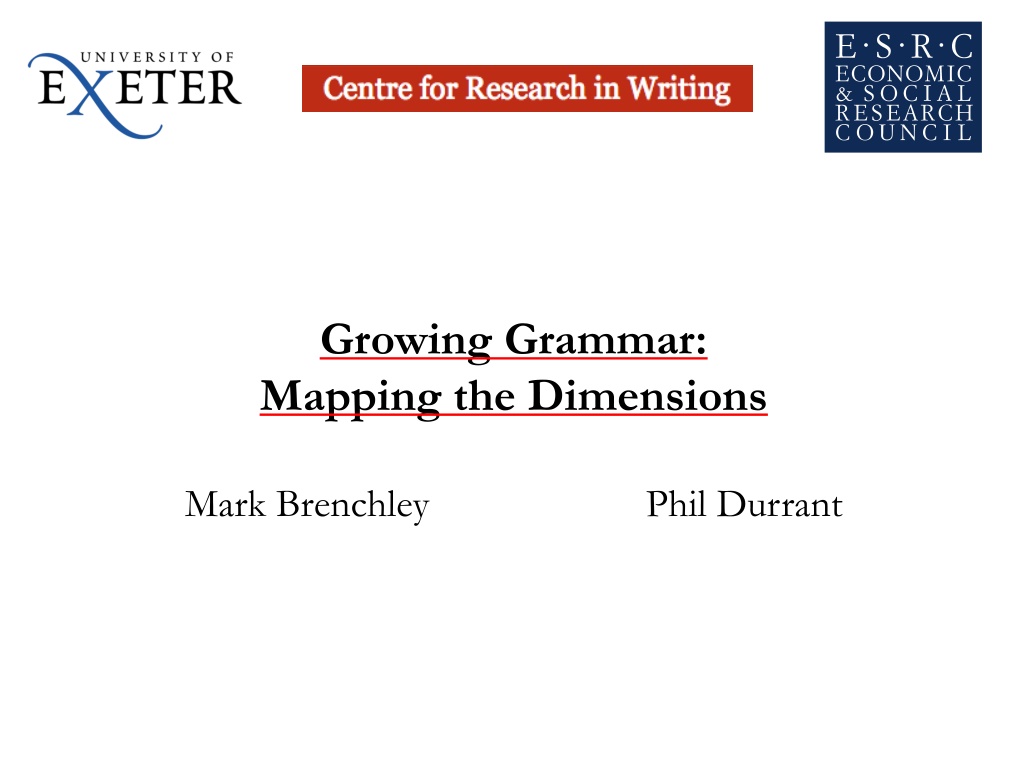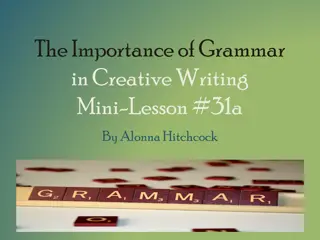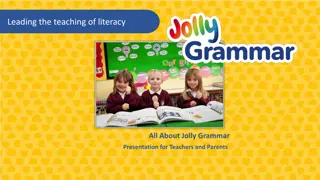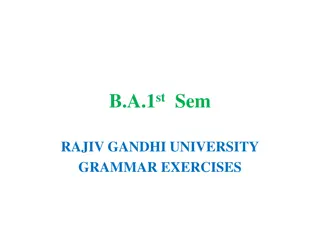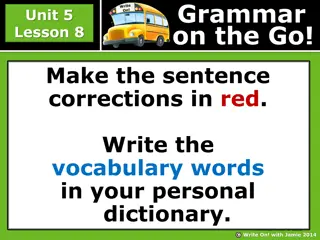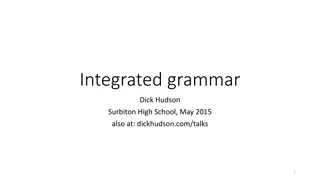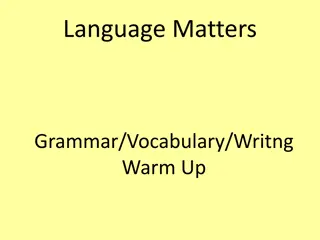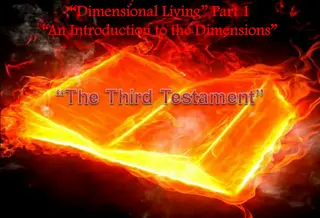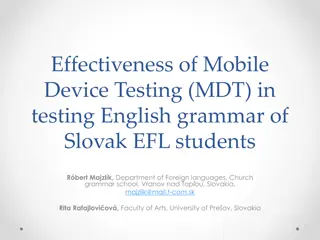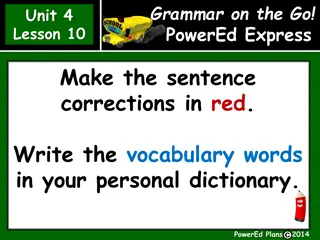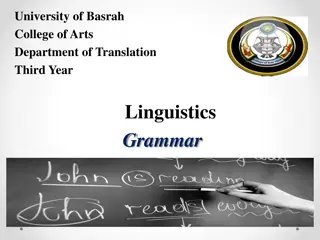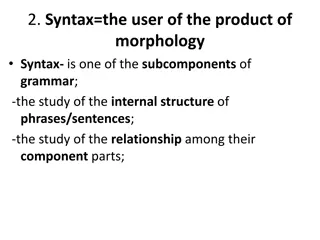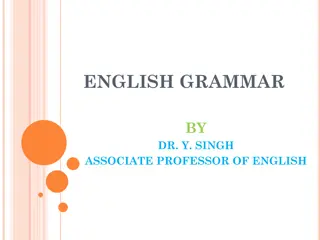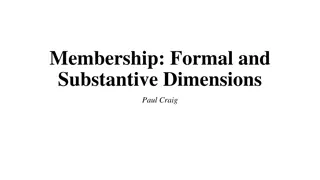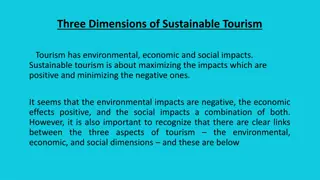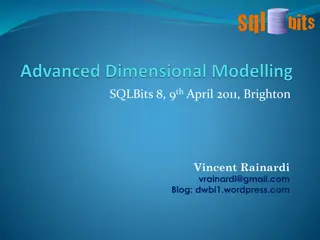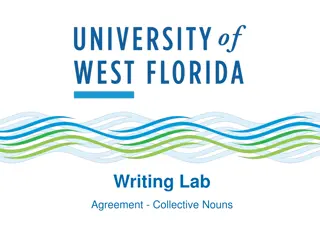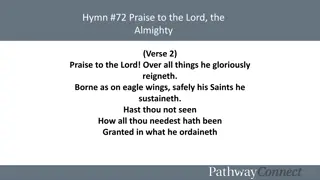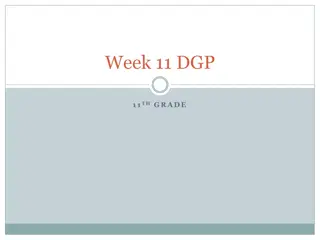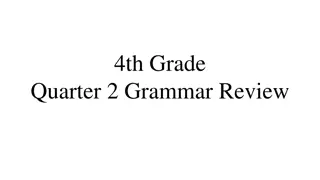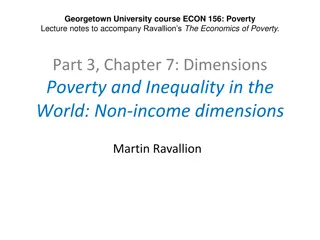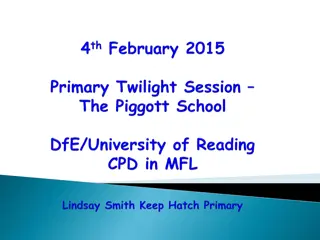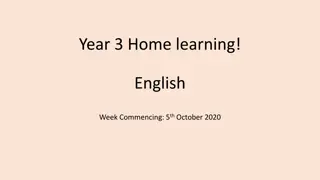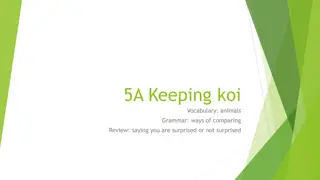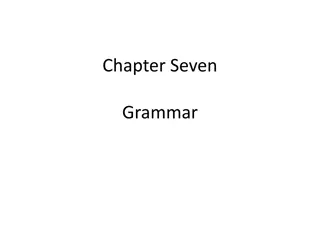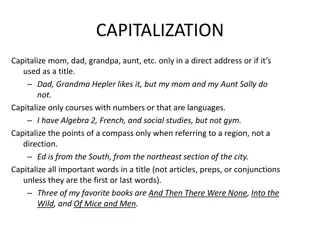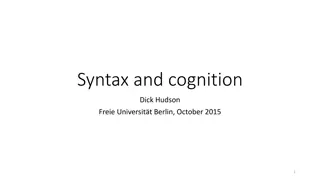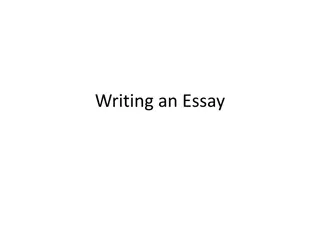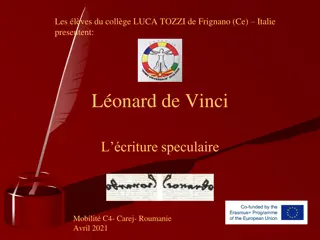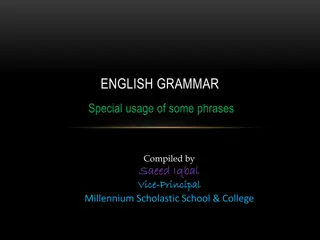Exploring Grammar Dimensions and Writing Development Insights
Delve into the intricate world of grammar dimensions, writing development, and systematic literature reviews. Discover how grammar is utilized in writing pieces and explore findings related to phrase and clause levels. Uncover insights on discourse flow and subject structures.
Download Presentation

Please find below an Image/Link to download the presentation.
The content on the website is provided AS IS for your information and personal use only. It may not be sold, licensed, or shared on other websites without obtaining consent from the author. Download presentation by click this link. If you encounter any issues during the download, it is possible that the publisher has removed the file from their server.
E N D
Presentation Transcript
Growing Grammar: Mapping the Dimensions Mark Brenchley Phil Durrant
The Grammatical Basis of Writing Development Exeter approach grammar construed not as an abstract system, but as something deployed in actual pieces of writing How is it deployed? How is is deployed developmentally?
one time ago there was a king called king james the first. and the catholics did not like him. and there was a bad man called Guy Fawkes he wanted to blow the houses of parliament he wanted to kill the king too. as well as the catholics he hid 36 barrels of gun powder and he hid it. Robert catesby sent a letter to the king. I am writing to express my opposition to the article regarding teenage tearaways which was recently published in your newspaper. I could not help but notice the considerable bias in the article but I read on, only to witness your reporter put words into your readers mouths sentence, after sentence, after sentence. Year 11 (15-16 yrs) Year 2 (6-7 yrs)
Here Be Dragons? teachers grammar
Mapping the Terrain Systematic literature review 8,058 initial texts 468 final texts 658 supplementary texts Not quite complete but general picture clear
Mapping the Terrain PLENTY OF INDIVIDUAL FINDINGS Phrase Level NP Structure (type and # of modifications) AGE (Crossley et al. 2011; Ravid & Berman, 2010) QUAL (Olinghouse & Wilson, 2013)
Mapping the Terrain PLENTY OF INDIVIDUAL FINDINGS Clause Level # Coordinated Clauses AGE (Veal, 1974) #Adverbial Clauses AGE (Noyce & Christie, 1985) # Relative Clauses QUAL (G&F, 1970)
Mapping the Terrain PLENTY OF INDIVIDUAL FINDINGS Discourse Flow Subject Opening Non-Finite Adverbial Clause Opening QUAL (Myhill, 2008) Subject-Verb Inversions QUAL (Myhill, 2008) QUAL (Myhill, 2008)
Mapping the Terrain PIECES OF A PUZZLE #1 Variation not necessarily continuous Continuous : - AGE Passives (Hunt, 1965) QUAL - Coordinated Clauses (Myhill, 2008)
Mapping the Terrain PIECES OF A PUZZLE #1 Variation not necessarily continuous Pick ups NP Modification: postgrads>11>7=4 (R&B, 2010) Participial Adjectives: high>medium=low (G&F, 1970) Drop Offs Adverbial Clauses: 7=5>3 (O Donnell et al, 1967) Relative Clauses: high=medium>low (G&F, 1970)
Mapping the Terrain PIECES OF A PUZZLE #2 Shifts of Grammatical Attention NP LENGTH: postgrads>11=7=4 NP ABSTRACTION: postgrads>11>7>4 NP MODIFICATION I: postgrads>11>7=4 NP MODIFICATION II: postgrads>11=7=4 (Ravid & Berman, 2010)
Mapping the Terrain PIECES OF A PUZZLE #3 Two Developmental Strands: AGE + QUALITY Sometimes align Relative Clauses QUALITY , AGE (Golub & Frederick, 1970) Modals QUALITY , AGE (Golub & Frederick, 1970)
Mapping the Terrain PIECES OF A PUZZLE #3 Sometimes don t Sentences with Adverbial Opening QUALITY: Good=Average=Weak AGExQUALITY: Good>Average>Weak @ 8 Good=Average=Weak @ 10 (Myhill, 2008)
Mapping the Terrain PIECES OF A PUZZLE #3 Sometimes don t Sentences with Non-Finite Adverbial Clause Opening AGExQUALITY: Good=Average=Weak @ 8 Good>Average>Weak @ 10 (Myhill, 2008)
Mapping the Terrain PIECES OF A PUZZLE #4 Importance of the Wider Diatypic Context Genre: T-Unit Length: A>D>N (Crowhurst & Pich , 1979) Audience: Clause Length: Teacher > Friend (Crowhurst & Pich , 1979)
Mapping the Terrain PIECES OF A PUZZLE #4 Genre: T-Unit Length: AGE @10: @6: A>D>N A>N, A=D, D=N QUAL @ARG: @NAR: Positive Relationship Negative Relationship (Crowhurst, 1980; Crowhurst & Pich , 1979)
Mapping the Terrain PIECES OF A PUZZLE #4 Genre: T-Unit Length: AGE @10: @6: A>D>N A>N, A=D, D=N QUAL @ARG: @NAR: Positive Relationship Negative Relationship AGExQUAL @12: @6: ARG: Positive Relationship NAR: Negative Relationship ARG: No Relationship NAR: No Relationship
Mapping the Terrain Words per Clause (Berman & Ravid, 2009) Content Words per Clause (Berman & Ravid, 2009)
Mapping the Terrain PIECES OF A PUZZLE #5 Systematicity? Not just about individual bits of grammar, but how they are interrelated
Mapping the Terrain PIECES OF A PUZZLE #5 Dean & Quinlan (2010) US Essay Writing (Descriptive, Persuasive) @ 4th, 6th, 8th, 10th, 12th grade e.g. Spoken Style : mental state/conversation verbs (+ve) first person singular pronouns (+ve) noun/verb ratio (-ve) attributive adjectives (-ve) AGE: @4/6/8/10/12: Negative Association QUALITY: @Persuasive: @Descriptive: Negative Association Positive Association
Mapping the Terrain Fragmentary evidence base, but pieces of underlying puzzle Problematic educationally how can we support teachers and students in putting all these pieces together more comprehensively? Value of a multi-dimensional approach, grounded in the work of Douglas Biber (1988) Language use can be modeled as a set of core communicative functions that cut across specific instances of language use Each function associated with specific clusters of grammatical features Writing development as students attaining and then better deploying the appropriate sets of grammatical features for expressing these underlying communicative functions in particular writing contexts
AND NOW FOR SOMETHING NOT COMPLETELY DIFFERENT
References Berman, R. A. & Ravid, D. (2009). Becoming a Literate Language User: Oral and Written Text Construction across Adolescence. In D. R. Olson & N. Torrance (eds.) Cambridge Handbook of Literacy (92-111). Cambridge: Cambridge University Press. Biber, D. (1988). Variation across speech and writing. Cambridge: Cambridge University Press. Crossley, S. A. et al. (2011). The development of writing proficiency as a function of grade level: A linguistic analysis. Written Communication 28(3), 282-311. Crowhurst, M. (1980). Syntactic complexity and teachers quality ratings of narrations and arguments. Research in the Teaching of English 14(3), 223-213. Crowhurst, M. & Pich , G. L. (1979). Audience and mode of discourse effects on syntactic complexity in writing at two grade levels. Research in the Teaching of English 13(2),101-109. Dean, P. & Quinlan, T. (2010). What automated analyses of corpora can tell us about students writing skills. Journal of Writing Research 2(2), 151-177. Golub, L. S. & Frederick, W. C. (1970). An analysis of children's writing under different stimulus conditions. Research in the Teaching of English 4(2), 168-180.
References Loban, W. (1976). Language development: Kindergarten through grade twelve. Urbana, IL: NCTE. Myhill, D. A. (2008). Towards a linguistic model of sentence development in writing. Language and education 22(5), 271-288. O Donnell, R. C. et al. (1967). A transformational analysis of oral and written grammatical structures in the language of children in grades three, five, and seven. The Journal of Educational Research 61(1), 35-39. Olinghouse, N. G. & Wilson, W. (2013). The relationship between vocabulary and writing quality in three genres. Reading & Writing 26(1), 45-65. Ravid, D. & Berman, R. A. (2010). Developing noun phrase complexity at school: A text- embedded cross-linguistic analysis. First Language 30(1), 3-26. Veal, L. R. (1974). Syntactic measures and rated quality in the writing of young children. Studies in Language Education, Report 8. Athens, GA: University of Georgia. Harpin, W. (1976). The Second 'R': Writing Development in the Junior School. London: Allen & Unwin. Hunt, K. W. (1965). Grammatical Structures Written at Three Grade Levels. Champaign, IL: NCTE.
